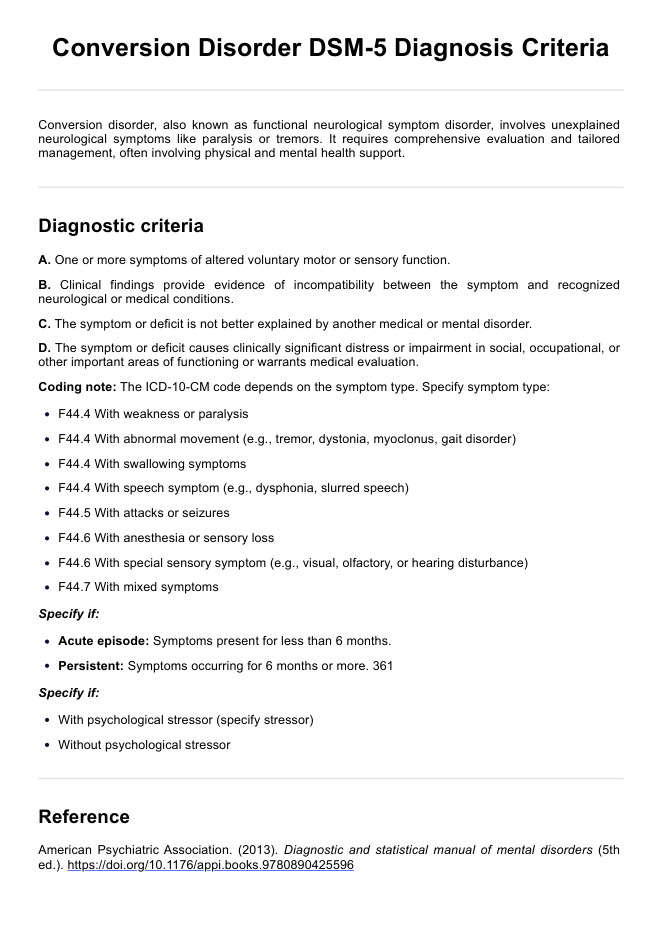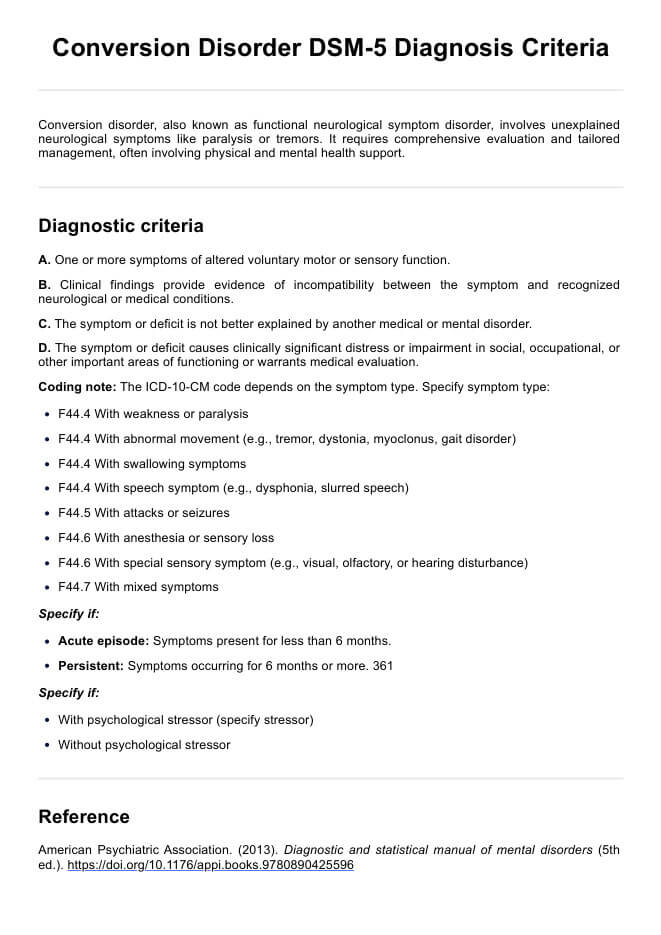Conversion Disorder DSM-5 Criteria
Explore effective strategies for managing conversion disorder, a condition with unexplained neurological symptoms, through expert care and tailored therapies.


What is conversion disorder?
Conversion disorder, now called functional neurological symptom disorder, involves one or more physical symptoms that impair motor or sensory function without an underlying neurological or medical condition (American Psychiatric Association, 2013a). The disorder is characterized by symptoms incompatible with recognized neurological diseases, such as functional motor symptoms or sensory deficits, and often merits medical evaluation. Effective management often requires a multidisciplinary approach, including psychological assessment and physical therapy. Diagnosis relies on ruling out other mental disorders and involves careful consideration of diagnostic criteria.
Conversion Disorder DSM-5 Criteria Template
Conversion Disorder DSM-5 Criteria Sample
How is conversion disorder diagnosed?
Diagnosing conversion disorder, or functional neurological disorder, involves a thorough assessment to differentiate it from other medical or mental disorders. DSM-5 requires the presence of one or more conversion disorder symptoms of altered voluntary motor or sensory function, such as weakness, abnormal movements, or swallowing signs inconsistent with recognized neurological disease (American Psychiatric Association, 2013a). The symptoms must cause clinically important distress or impairment, warranting medical evaluation.
The process begins with a comprehensive clinical evaluation to rule out other potential neurological or medical disorders. Neurological symptoms are carefully assessed, and the diagnosis hinges on identifying inconsistencies between the symptoms and known neurological diseases. Functional neurologic symptoms, including motor symptoms like paralysis or tremor, and sensory symptoms like altered sensation, must be present and not better explained by somatic symptom disorder.
A mental health professional may evaluate psychological factors contributing to the disorder in addition to physical assessments. Patients are at increased risk if a family member has a functional neurologic disorder or if they've experienced physical or sexual abuse as a child or any other trauma in life. Accurate diagnosis requires a multidisciplinary approach to ensure all aspects of the patient’s symptoms are considered and appropriately managed (American Psychiatric Association, 2013a).
Conversion disorder DSM-5 diagnosis criteria
Functional Neurological Symptom Disorder (Conversion Disorder) is diagnosed according to specific criteria outlined in the DSM-5 (American Psychiatric Association, 2013a):
A. One or more symptoms of altered voluntary motor or sensory function.
B. Clinical findings provide evidence of incompatibility between the symptom and recognized neurological or medical conditions.
C. The symptom or deficit is not better explained by another medical or mental disorder.
D. The symptom or deficit causes clinically significant distress or impairment in social, occupational, or other important areas of functioning or warrants medical evaluation.
Coding note: The ICD-10-CM code depends on the symptom type. Specify symptom type:
- F44.4 With weakness or paralysis
- F44.4 With abnormal movement (e.g., tremor, dystonia, myoclonus, gait disorder)
- F44.4 With swallowing symptoms
- F44.4 With speech symptom (e.g., dysphonia, slurred speech)
- F44.5 With attacks or seizures
- F44.6 With anesthesia or sensory loss
- F44.6 With special sensory symptom (e.g., visual, olfactory, or hearing disturbance)
- F44.7 With mixed symptoms
Specify if:
- Acute episode: Symptoms present for less than 6 months.
- Persistent: Symptoms occurring for 6 months or more. 361
Specify if:
- With psychological stressor (specify stressor)
- Without psychological stressor
Differences between the DSM-4 and DSM-5 criteria
The criteria for diagnosing Conversion Disorder, or Functional Neurological Symptom Disorder, have been updated to highlight the crucial role of a thorough neurological examination. This change acknowledges that relevant psychological factors may not always be evident or measurable during diagnosis. The revised criteria stress that while the neurological evaluation is essential to differentiate the disorder from other conditions, psychological aspects contributing to the symptoms may not be immediately apparent (American Psychiatric Association, 2013b).
How is conversion disorder treated and managed?
Treating and managing conversion disorder (functional neurological symptom disorder) involves a multifaceted approach aimed at addressing both physical and psychological aspects of the condition. This disorder requires careful consideration of its complex nature.
Physical therapy and occupational therapy
These interventions are crucial for managing weakness, gait abnormalities, and abnormal movements. It focuses on improving motor function and mobility, while occupational therapy helps individuals adapt to daily living activities despite their functional impairments.
Psychotherapy
Addressing any underlying psychological factors, such as stress or trauma, is essential. Cognitive-behavioral therapy (CBT) is particularly effective in helping patients understand and manage their symptoms. This approach can also be beneficial in addressing related conditions like illness anxiety disorder, somatic symptom disorder, and other mental health problems.
Multidisciplinary care
A coordinated approach involving neurologists, psychiatrists, and psychologists is often necessary. This team can ensure comprehensive care, addressing both the functional neurologic symptoms and any associated mental health conditions.
Education and support
Educating patients about their condition and providing support can help alleviate symptoms and reduce distress. Ensuring patients understand their symptoms are not due to a neurological disease but genuine experiences is a critical part of management.
Monitoring and follow-up
Regular follow-up is necessary to adjust treatment plans based on the patient's progress and to address any new symptoms or issues.
By integrating physical and psychological treatments, healthcare professionals can effectively manage conversion disorder and improve patients' overall quality of life.
References
American Psychiatric Association. (2013a). Diagnostic and statistical manual of mental disorders (5th ed.). https://doi.org/10.1176/appi.books.9780890425596
American Psychiatric Association. (2013b). Highlights of changes from DSM-IV-TR to DSM-5. https://www.psychiatry.org/File%20Library/Psychiatrists/Practice/DSM/APA_DSM_Changes_from_DSM-IV-TR_-to_DSM-5.pdf
Commonly asked questions
The exact cause of conversion disorder is not well understood. However, it is often associated with stress, trauma, or psychological factors. It may occur in response to significant emotional or physical stress, but these factors are not always evident at the time of diagnosis.
Treatment typically involves a multidisciplinary approach. Physical therapy and occupational therapy help address motor symptoms and improve function. Psychotherapy, particularly cognitive-behavioral therapy (CBT), can assist in managing psychological factors and related mental health conditions. Education and support for patients and their families are also crucial.
While there is no specific cure, many individuals experience significant improvement with appropriate treatment. Early intervention and a comprehensive treatment plan can help manage symptoms and enhance quality of life.





















-template.jpg)


















































































